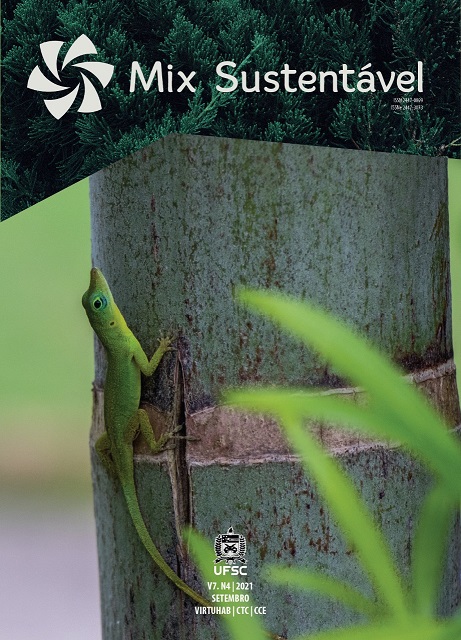FEASIBILITY STUDY FOR THE PRODUCTION OF SUSTAINABLE COMPOSITE FILAMENT FOR 3D PRINTING FROM A PLA MATRIX REINFORCED WITH WOOD FIBER RESIDUES
DOI:
https://doi.org/10.29183/2447-3073.MIX2021.v7.n4.115-126Keywords:
Additive manufacturing, Filaments, SustainabilityAbstract
Technological processes of additive manufacturing, such as 3D printing, allowed to transcend the limits of the development of current products at a lower cost in a faster way. In recent years, 3D printing has become easier to use and cheaper, making it accessible to different markets. The literature has shown that there is a great demand to design more sustainable materials for the manufacture of consumer goods by 3D printing, which includes, for example, the use of industrial process residues from the furniture industry as powders and sawdust incorporated into polymer matrices. In this work, the combination of PLA with wood dust residues was used in order to create a wood-like filament, with better mechanical properties than the filament without the addition of the load and thus more sustainable. For this, the characterization of the wood powder was done first to determine the best process parameters and then three different and extruded formulations were determined for the production of the filaments. At the end, they were analyzed for their properties of interest.References
BARBOSA, A. P. Características estruturais e propriedades de compósitos poliméricos reforçados com fibras de buriti. 2011. Disponível em: http://uenf.br/posgraduacao/engenharia-de-materiais/wp-content/uploads/sites/2/2013/07/Tese-de-doutorado-_fibras-de-Buriti_.pdf. Acesso em: 04/10/2019.
BRENT, T.; LIU, Z.; FINKENSTADT, V.; LEWANDOWSKI, B.; OTT, S.; REIFSCHNEIDER, L. 3D printing biocomposites. 2015. Disponível em: <10.2417/spepro.005690>. Acesso em: 05/09/2019.
CHIA, H. N.; WE, M. B.; Recent advances in 3D printing of biomaterials. 2015. Disponível em <https://doi.org/10.1186/s13036-015-0001-4> Acesso em: 03/03/2019.
FERNANDES, J. F. M. Estudo da Influência de Parâmetros de Impressão 3D nas Propriedades Mecânicas do PLA. 2016. Disponível em: <https://fenix.tecnico.ulisboa.pt/downloadFile/281870113703681/Dissertacao_73521.pdf>. Acesso em: 18/04/2019.
FREITAS, J. C. Obtenção e caracterização de peças porosas de alumina obtidas por gelatinização. 2014.
GREENE, TIM. The Role of 3D Printing in Factory 4.0. IDC, Analize the future. White Paper. 2017.
KARIZ, M.; SERNEK, M. Effect of wood content in FDM filament on properties of 3D printed parts. 2018. Disponível em: <https://doi.org/10.1016/j.mtcomm.2017.12.016>. Acesso em: 03/09/2019
LE DUIGOUA, A.; CASTROB, M.; BEVANC, R.; MARTIN, N. 3D printing of wood fibre biocomposites: From mechanical to actuation functionality. 2016. Disponível em: <https://doi.org/10.1016/j.matdes.2016.02.018>. Acesso em: 22/09/2019
MORESCO, Mauro. Efeito de agente de acoplamento em compósitos de polipropileno com cargas vegetais. Trabalhos de Conclusão de Curso de Graduação. Universidade Federal do Rio Grande do Sul. Escola de Engenharia. Curso de Engenharia de Materiais. 2009.
NATURE WORKS. Ingeo™ Biopolymer 2003D Technical Data Sheet. Disponível em: https://www.natureworksllc.com/~/media/Technical_Resources/Technical_Data_Sheets/TechnicalDataSheet_2003D_FFP-FSW_pdf.pdf. Acesso em: 20/09/2019.
OLIVEIRA, B. M.; FILHO, J. M.; AFONSO, J. C. A densidade e a evolução do densímetro. 2013. Disponível em https://www.scienceopen.com/document?vid=cb623ba1-d2f1-4050-bc15-313392598f11. Acesso em 04/10/2019
PETINAKIS, E.; YU, L.; EDWARD, G.; DEAN, K.; LIU, H.; SCULLY, A. D. Effect of Matrix–Particle Interfacial Adhesion on the Mechanical Properties of Poly(lactic acid)/Wood-Flour Micro-Composites. 2009. Disponível em: <10.1007/s10924-009-0124-0>. Acesso em: 15/08/2019.
REIS, D. C. N. S. P. Importância do estudo da área superficial específica e porosidade do estearato de magnésio para o setor farmacêutico. 2013. Disponível em: <https://www.arca.fiocruz.br/handle/icict/7720>. Acesso em: 22/09/2019
ROCHA, M. C.G.; COUTINHO, F. M. B.; BALKE, S. Índice de Fluidez: Uma Variável de Controle de Processos de Degradação Controlada. De Polipropileno por Extrusão Reativa. Polímeros: Ciência e Tecnologia, vol.4, n3, p.33-37, 1994.
SCHUBERT, C.; VAN LANGEVELD, M. C.; DONOSO, L. A.; Innovations in 3D printing: a 3D overview from optics to organs. 2014. Disponível em: http://dx.doi.org/10.1136/bjophthalmol-2013-304446. Acesso em: 10/10/2019
TAO, Y.; WANG, H.; LI, Z.; LI, P. Development and Application of Wood Flour-Filled Polylactic Acid Composite Filament for 3D Printing. 2017. Disponível em: <10.3390/ma10040339>. Acesso em: 15/06/2019.
TEIXEIRA, M. G.; CESAR, S. F. Produção de compósito com resíduo de madeira no contexto da ecologia industrial. 2006. Disponível em: <http://madeira.set.eesc.usp.br/article/view/219> Acesso em: 05/11/2019
WANGA, X.; JIANGB M.; ZHOUB Z.; GOUA, J.; HUIC D. 3D printing of polymer matrix composites: A review and prospective. 2017. Disponível em: <https://doi.org/10.1016/j.compositesb.2016.11.034>. Acesso em: 16/09/2019
ZHONG, R. Y.; XU, Xun.; KLOTZ, Eberhard.; NEWMAN, S. T. Intelligent Manufacturing in the Context of Industry 4.0: A Review. 2017. Disponível em <http://dx.doi.org/10.1016/J.ENG.2017.05.015>. Acesso em: 11/12/2018.
Downloads
Additional Files
Published
How to Cite
Issue
Section
License
Creative Commons Copyright Notice
Attribution 4.0 International




